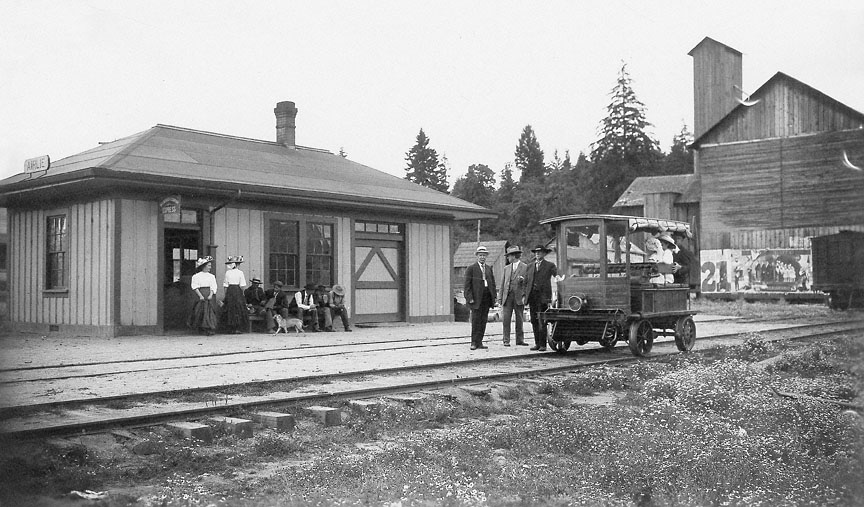- Catalog No. —
- OrHi 55748
- Date —
- 1909
- Era —
- 1881-1920 (Industrialization and Progressive Reform)
- Themes —
- Geography and Places, Transportation and Communication
- Credits —
- Oregon Historical Society
- Regions —
- Willamette Basin
- Author —
- Unknown
Railroad Station at Airlie, 1909
The photograph above shows the railroad station of the Southern Pacific Company and a warehouse at the small Willamette Valley town of Airlie in 1909. Airlie is a place-name reminder of Scottish investment in Oregon industry in the 1870s, when William Reid of Dundee, Scotland, took the reins of a failed narrow-gauge enterprise, the Willamette Valley Railroad. As the Oregonian Railway, the company laid tracks south from Dundee to Broadmead, Dallas, Monmouth, and Airlie, where construction ended in September 1881; a connection with Portland on the north opened in 1887. The terminus was named for the Oregonian Railway president, the Earl of Airlie. The aimless and bankrupt enterprise was acquired by the Southern Pacific in 1890 and converted to standard gauge, but Airlie remained the unplanned terminus of a very minor branch line, a small shipping point for wheat. Polk’s Oregon & Washington Gazetteer for 1908-1909 lists the town’s meager business enterprises as two general merchandise stores, a meat market, the warehouse of Hoffman & Jamieson, and the hop growers Norton, Wiley & Son. The structure at the right appears to be a warehouse and hop dryer. The railroad erected one of its standard plan combination stations at Airlie, a plain structure with vertical board-and-batten siding and a hipped roof, painted mustard yellow with brown trim. There was a small passenger waiting room and a storage room for freight and express shipments. The station agent also represented Wells, Fargo & Co.’s express and the Postal Telegraph system. The small railcar is an oddity, the homemade gasoline car of the Independence & Monmouth Railroad. For several years, the I&M contracted to operate passenger train service from Airlie to Monmouth and Independence, and this car was enough for the meager traffic. Small towns similar to Airlie were dotted along the railroad lines of Oregon from the 1880s into the 1920s. They were comprised of several small merchants, a few modest agriculture- or timber-related mills or enterprises, a standardized railroad station, and a post office. The railroad from Monmouth to Airlie was abandoned in 1927, and the community was virtually abandoned during World War II when the surrounding land was incorporated into Camp Adair. Today it is a crossroads best known as the site of the Airlie Winery. Written by Richard Engeman, © Oregon Historical Society, 2005.
